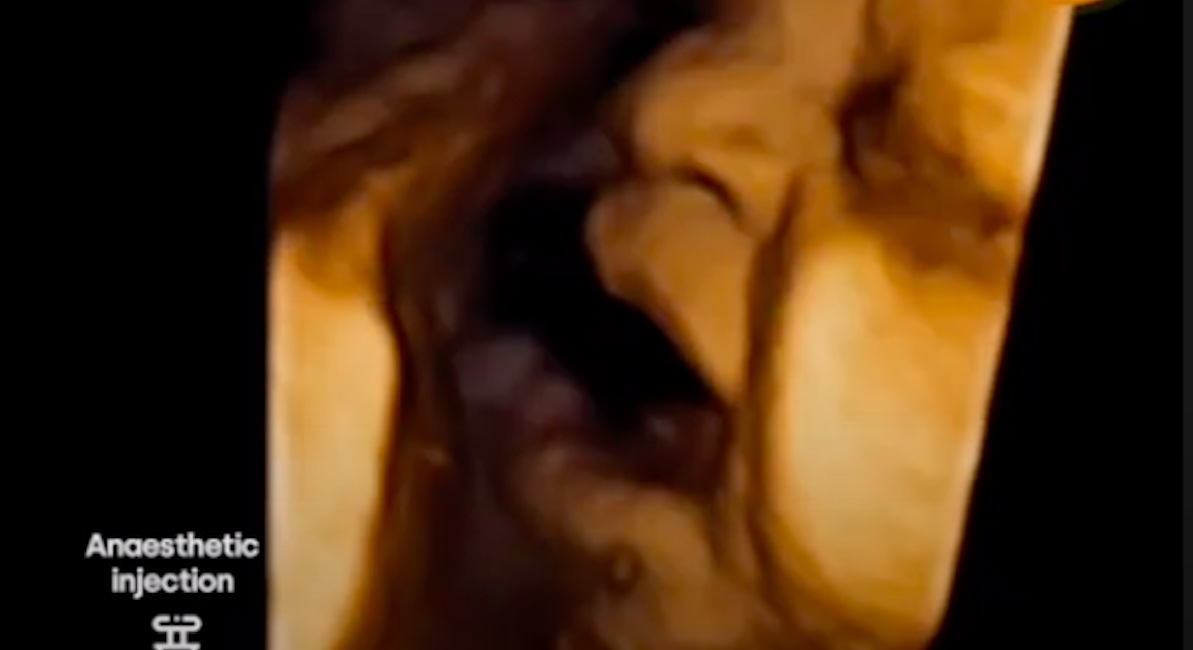A new study has confirmed that preborn children in the third trimester are capable of reacting to a painful stimulus. The babies, ages 28 to 34 weeks in gestation, took part in the study, which used an injection of anesthesia along with 4-D ultrasound imaging to evaluate the babies’ responses to that injection.
Measuring levels of pain
Thirteen mothers took part in the study. Five of the babies each had a diaphragmatic hernia and the remaining eight were labeled as healthy. The babies were split into three groups. The first was called the “acute pain group” and included the five babies who would be receiving an anesthetic injection prior to undergoing intrauterine surgery for their diaphragmatic hernias. Their facial expressions were recorded for 45 seconds before the injection and 45 seconds after the injection. The second group was the “control group at rest,” which were babies who were recorded during a routine ultrasound “after a 5-minute period of rest for the mother, in a quiet and dark room for 45 seconds.” The third group was the “control group acoustic startle” and included babies who were recorded by ultrasound while being stimulated with acoustics. Their facial expressions were recorded 45 seconds prior to the stimulus and 45 seconds after.
The recordings were then evaluated by two researchers who were unaware of which baby was which. They scored the images of each baby using the Neonatal Facial Coding Systems, which monitors facial expressions in preborn children to evaluate the degree of pain they experience. The researchers watched for brow lowering, eyes squeezing shut, deepening of the furrow of nose and lip, open lips, horizontal mouth stretch, vertical mouth stretch, and neck deflection. Each baby received one point for each action that was present.
The research found that none of the babies in the control groups scored higher than four, while the babies in the acute pain group scored no less than five. The researchers concluded, “[O]ur data indicate AP [acute pain] group participants exhibited an acute nociceptive-related [pain-related] facial response, that may have been experienced as pain.”
While the researchers state that pain cannot be determined from facial expressions alone, they said the babies’ “inability to communicate does not negate the possibility that a human […] experiences pain” and that these babies may have in fact been experiencing pain from the injection.
READ: Pro-abortion researcher admits: Preborn babies feel pain far earlier than we thought
Babies who are aborted feel pain, too
This study lends credence to the idea that babies are aware when a foreign object enters their space. Board-certified Registered Diagnostic Medical Sonographer Sarah Cleveland once described witnessing an 18-week preborn child “dart away” from an amniocentesis needle and “move as far away as possible to the other side of the womb.” She said, “He stopped kicking and playing […] His little heart rate skyrocketed. He was scared.”
While most people — both pro-life and pro-abortion — are aware that babies in the third trimester are capable of feeling pain, abortion advocates have argued that third-trimester induction abortions provide humane deaths for babies via cardiac arrest, especially those given a poor prenatal diagnosis who may die at or shortly after birth. The erroneous pro-abortion argument is that it is compassionate to give a lethal injection to a child rather than to allow him or her to potentially suffer.
Regardless of whether a preborn child experiences pain, it is wrong to kill him
It does not matter how preborn babies are killed by abortion or whether or not they are aware they are being killed or even that they feel the pain of being killed. (They do.) It is the fact that they are being killed that is the problem.
Abortion is not morally acceptable, whether or not a child in the womb can or cannot feel pain. Human beings are human beings at every stage of development, regardless of whether their nerve receptors are functioning.
Take, for example, Gabby Gingras, one of a small group of individuals who cannot feel pain due to a rare gene. Gabby’s parents spend a large amount of their time trying to protect her from the pain she cannot feel. Because Gabby is unable to feel pain, as a young child she would bite her own fingers, poke her own eye until it had to be removed, and even pull out her teeth. Yet her inability to sense pain has no bearing on her humanity.
Pain is our indicator that something is wrong and it causes us to react and then act to stop whatever is causing the pain. The babies in this study who received injections cannot act to stop the pain being caused to them, but their reaction proves they do feel.
Humanity is not based on the ability to feel pain, nor does it depend on a mother’s financial status or career aspirations, or a father’s horrific crime of rape, or a poor prenatal diagnosis. Humanity is constant from the moment of fertilization — when life begins.
“Like” Live Action News on Facebook for more pro-life news and commentary!







